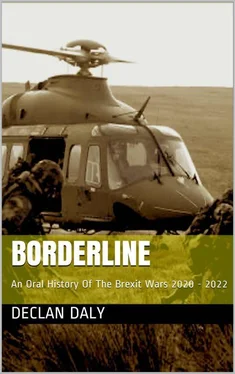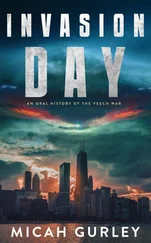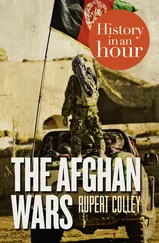Russia took advantage of this window to begin resupply by air. With no air defence assets available to the Air Corps, and with RAF jets no longer taking the hand off of incoming Russian aircraft from other NATO forces if the trajectory was towards Irelands West coast rather than Scotland, Russian transport aircraft began nocturnal drops of GPS (or rather GLONASS, the Russian sattelite based navigation system), guided parachute drops. Cheap and effective, these packages of up to a half tonne each were dropped under massive self steering rectangular parachutes from high altitude. The prevailing westerly winds did the rest, taking their deadly cargo to dropzones in both Ireland and Northern Ireland depending on the intended recipient. Not all got there however, some parachutes were recovered from the nets of Donegal fishing boats, but the most infamous was the one that tangled on the pinnacle of Mount Errigal in Donegal and spilled its load of small arms and rocket launchers down the steep sides of that mountain.
This method was able to succeed so quickly, so early because of the pattern of behaviour that had been built up over years of Russian long range aircraft flying down the west coast of Ireland without any more inconvenience than posing a danger to commercial traffic by not using their transponders to identify exactly where they were. Simply put, the wolf had scratched at the door and gone on its way so many times that no one thought it would ever bite.
During the start of this phase, the first constituted units of the new Northern groups, as opposed to the IRA, began to return home. They did not begin major operations however, with the exception of the fighting between the dissidents and the IRA for border access. There was still killing as each group bumped up against each other, but the worst was still ahead. It is uncertain at what point that each group realised that they had all been supplied by Russia, but many individual rubicons had been passed by then and they could not complain, less they be cut off from supplies and overwhelmed by their enemies.
◆◆◆
Phase Three – Status Quo
Once the French QRA operating out of Shannon became established, the frequency of supply did not diminish, rather it blended modes and changed form from time to time. Rather than one or two transport aircraft that could easily be intercepted by the detachment, there might be a trail of successive flights of transports, maritime patrol aircraft and the occasional White Swan, a large intercontinental bomber. By swarming like this and moving through flight levels and airways that were used by commercial traffic, the Russians were able to absorb the available interceptors and prioritise where those jets went by posing an imminent threat to the safety of civilian air travel. This allowed them to continue airborne resupply missions, but with deniability now stretched wafer thin. This might happen day after day for a week, and then nothing for a month.
Equally during this phase, the ships and aircraft of Operation Saltmine saw an uptick in trawlers flagged in various states entering Irish waters. Effectively a similar technique was used here – an attempt to swarm the capacity of the available assets and then carry on with deliveries once they were saturated. Always assumed, but never proven without a proper sub sea monitoring capability, was that submarine activity was increasing as well. Again, the evidence was being provided by the fishermen of Killybegs, with the incidence of ships being mysteriously dragged by their nets or in one case almost overturned by submerged vessels going up all the time.
It is unclear at this time if this phase has come completely to a close.
◆◆◆
Interlude: Red Team ‘On the inapplicability of work group targetting in the current counter insurgency climate'
“Brendan” Red Team Member
‘The joke in the DF was always that if we were ever attacked, we’d have to nuke Newbridge (where the DOD is located) on the first night and then turn to face the next enemy, because we were too small to fight a war on two fronts. There’s some in the civil service who say we cajolled or threatened the staff that left when the Senator took over, but that’s not true at all. He directed that, as a somewhat outside agency in that we were all exers, we should do an analysis of the whole defence organisiation, our enemies as they existed at the time and provide a report on the strengths and weaknesses we observed. That of course included the civil side of the house in DFHQ. I think he just wanted more evidence for what he already knew.
To the surprise of some, we spent as much time on anthropological factors as we did on the tenets of guerilla warfare and counter insurgency force requirements. One thing that we leaned on was the existence of work groups – this is a brief overview, we actually conducted studies and surveys to prove our findings as well – and the cultures that existed within each work group.
What I mean by that is, that you could have a body of people who existed within a distinct working environment, for example, Infantry officers. They brought with them into HQ appointments an existing set of mental tools and a cultural prism through which they viewed the world. There were unwritten things that were acceptable and unacceptable to them, that might be different to another work group. These were things that were built, not just on their own personal experience, but of all those others who had come before them. Air Corps Commandants (Comdts) proved to be the hardest to pin down in this, by the way, and represented something of an outlier statistically.
This was because they were often working as squadron commanders, line pilots, instructors and staff officers all at the same time, so they belonged to all these different work groups and were hard to define. We found, with a bit of digging, that they would act in the same way as the group they personnally identified with most, rather than the one they were necessarily in. So if a pilot saw himself as a line pilot, he would act like that and be out of sync with his role as a HQ staff officer. But all that’s an aside.
The real red light that came on was the acceptability of military failure amongst senior civil servants in the DOD, so long as bureaucratic process was followed and their own very strict control over entirely military responsibilties was maintained.
They were happy enough for capabilities to be lost through the personnel retention crisis, so long as they could squeeze the existing budget and try to bring in new, inexperienced, replacements. This, and it was very clear from the start, was not going to mesh well with the incoming ministerial drive to accelerate processes like recruitment and replenishment of equipment and the expansion of capabilities. Simply, there was a cultural divide that could not be crossed and those civil servants that left saw that and retired before they were nudged out to watch paint dry as the assistant secretary of bathroom refurbishment or whatever. We had recommended moves to change the culture that existed alright, but they upped and left before anything we suggested could be implemented.That was the sum total of our involvement, I just thought I should clear that up, as we get a very ominous reputation sometimes that is not entirely deserved!
We applied a similar analysis approach to the IRA, but without Survey monkey being trotted out of course! What we found was that they were actually harder to split up into groups, I mean, of course you had the cell structure etc – that was all dealt with under the counter insurgency heading of the report. No, what I’m saying is that culturally, you only really had two groups. These were the old command network that existed from the olden days and the new recruits. This second group, no matter what position of responsibility they were put in, they were still raw and inexperienced. Well trained, but not experienced. This meant that for us to react to that, well, we couldn’t go down the line of the NATO forces in Afghanistan or the Americans world wide where you target the middle management, the operational level officers who tie the whole thing together, because they weren’t really there yet.
Читать дальше












